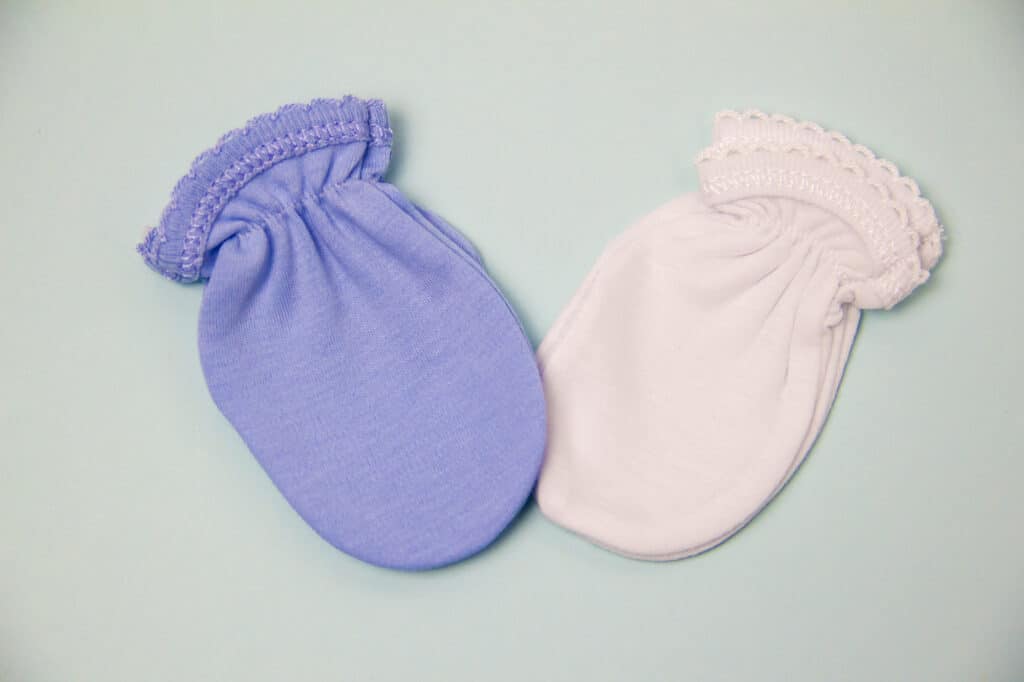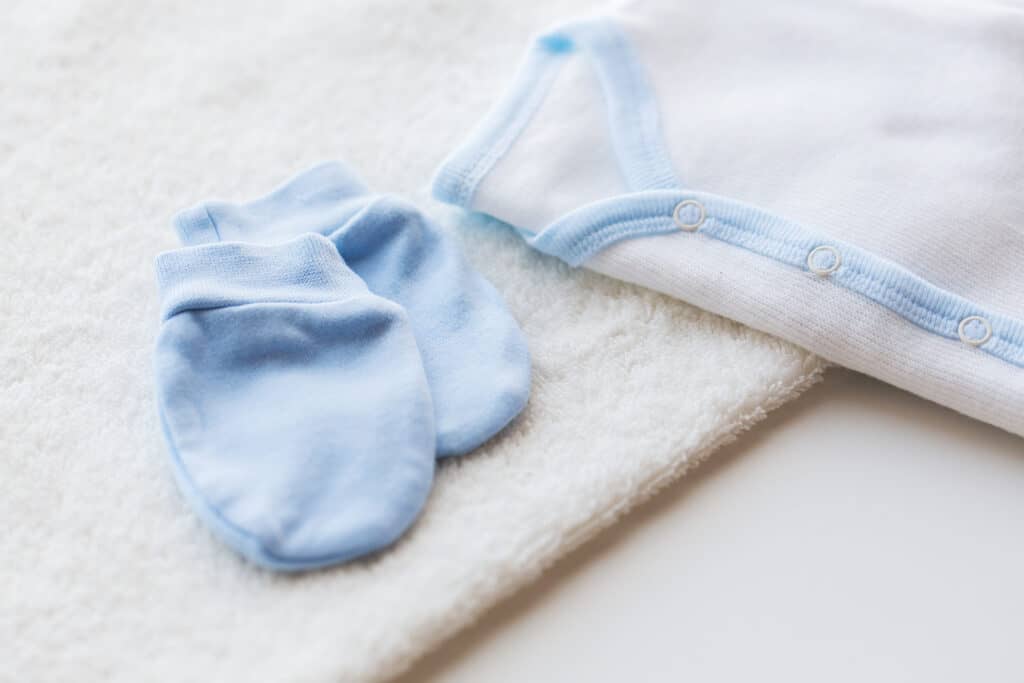Are you wondering if putting mittens on newborns is actually beneficial? As the parent of a new bundle of joy, it can be quite overwhelming trying to figure out what’s best for your baby.
Newborn baby mittens serve an essential purpose and have multiple benefits. Most notably, mittens are designed to prevent babies from scratching and irritating their delicate skin.
From preventing scratches to keeping tiny hands warm in even the chilliest of temperatures, mittens offer a host of benefits for babies.
We’ll cover why mittens are recommended for newborn infants and share some tips about how to use them correctly so that your precious baby enjoys all the advantages they have to offer.

Baby Mittens: What Are They?
Baby mittens, also known as “scratch mitts”, are small gloves made with soft fabric that are used to protect babies from scratching themselves. Babies can scratch their delicate skin unintentionally with their fingernails and baby mittens help to alleviate this problem. They usually have an elastic band or cuff around the wrist which helps keep them on the baby’s hands.
One of the main reasons why a baby might need to wear mittens is due to sharp newborn nails that can easily scratch a baby’s face and body parts like legs and arms without any kind of protection.
Newborns often tend to use their hands for exploring things so keeping their nails short and using some kind of protective covering over them will not only reduce the risk of accidental scratches but also lessen any discomfort due to long nails digging into the skin while they move around.
Besides protecting against self-inflicted injuries, baby mittens can also be useful in preventing excessive heat loss by providing an extra layer of warmth during cold weather conditions as well as keeping germs away from an infant’s mouth if they begin teething or finger sucking habits.
Are Baby Mittens Necessary?
Baby mittens are not necessary, in fact, some parents opt not to have their babies wear them at all.
Although not an absolute necessity, they can be extremely useful in keeping newborns’ tiny fingertips protected from their curious hands and those of others. Ultimately, it is up to every family to decide if baby mittens are necessary for their precious children – we’re sure you’ll pick the best solution for your particular needs!
Baby Mittens and Sleep
Can you let a newborn baby sleep with mittens? No is the simple answer.
Baby mittens are not recommended for sleeping since they can be a suffocation hazard. It’s very easy for them to slip off unknowingly, and an infant has no control over their hands or arms while they’re asleep. Moreover, if the baby were to stick their hand in their mouth or choke on the mitten itself, it could lead to serious danger.
If you have a newborn that has difficulty keeping their hands from entering their mouth while asleep and wants extra warmth, there are plenty of safer alternatives.
Swaddles are becoming increasingly popular as parents look for ways to help keep babies warm and safe during snoozing hours. These swaddles securely wrap your baby gently but firmly with adjustable Velcro fasteners which make it difficult for infants to come out of them at night without your help!
Another great alternative is putting socks or footed sleepers on your baby rather than using mittens – this will keep them warm all night long without the risk of suffocation due to slipping off during sleep.
If you still feel uneasy about leaving any kind of garment on your baby while they sleep, you can use an old-fashioned “sleeping sack” – these usually come with zippered closures so that you won’t need to worry about anything getting too loose as well as providing more room for movement within the sack itself compared with traditional blankets!
No matter what you decide to dress your baby in for sleeping, always be sure to adjust clothing and bedding layers according to changes in room temperature throughout each season and make sure airways remain totally unobstructed during naps and nighttime sleeping sessions; doing both of these things should help ensure safe sleeping conditions every single time!
When Should Babies Stop Wearing Mittens?

The general rule is that babies should stop wearing mittens once they start to reach out for things on their own – usually around 4 months of age or when they begin grasping objects such as toys or their own feet. This is because mittens restrict the use of the index finger which helps with coordination and precision movements required for more advanced gross motor skills like crawling and walking.
Once these milestones have been achieved, small toys become much easier to hold with all fingers free and accessible so, therefore, it makes sense to remove the mittens at this stage also.
From a cognitive perspective, removing the mittens allows babies to properly explore objects by touching them without interference which helps stimulate learning about cause and effect: what happens when I press this button? Or shake this toy? Unlocking tactile senses here is important for further sensory processing that will eventually lead to language acquisition later on in life.
So yes, in conclusion, it’s best practice not to let your child wear mittens beyond 4 months old (unless temperatures require) as having unrestricted access to their environment – through touch – during this developmental period has major benefit potential!
Are There Newborn Mitten Alternatives?
Yes, absolutely! Baby mittens are an important item for infants, as they help prevent them from scratching themselves. However, there are some safer alternatives you can consider when keeping your child away from their fingernails.
The first option is to use a baby nail file. These tools come in a variety of shapes and sizes and offer an effective way to keep little ones’ nails smooth without getting their delicate skin caught in the fabric of mittens.
Additionally, baby nail files can be used with minimal risk of cutting the skin – something that could happen if mitten fabrics get too tight or catch on a sharp edge while they move around during sleep time or playtime.
If you have an infant who isn’t quite mobile yet or whose nails aren’t long enough that they’d be able to scratch themselves, cotton socks can be applied over their hands as an alternative option. Make sure the socks fit comfortably and won’t slip off should your baby start wriggling.
Like baby mittens, socks should not be worn without supervision and should always be checked regularly for any signs of discomfort.
Safety Tips And Considerations For Mittens on Newborns
1. Choose the right size mittens: Mittens that are too big can fall off and cause suffocation hazards while ones that are too small will be uncomfortable or even restrict circulation.
2. Avoid strings or loose fabric around the wrist: Strings and ribbons on mitten cuffs may make them look cute, but they can also be strangling hazards for babies – avoid any extra fabric here!
3. Monitor for overheating: Babies tend to get sweaty in their hands when wearing gloves and mittens, which can lead to overheating if not monitored carefully enough. Make sure your baby’s outfit isn’t too warm overall, as well as checking their temperature often (especially during hot summer months). Also take off the gloves if your baby becomes too fussy or agitated – it could mean they’re getting uncomfortable due to being too hot!
4. Wash regularly: Keeping them clean is always important with kids’ clothes and accessories – so don’t forget about those mittens either! Make sure you wash the mittens regularly according to care label instructions (usually gentle cycle in cold water) or just hand-wash them once a week depending on how often they’re worn by your baby.
To conclude, baby mittens can be a great way to protect your baby from scratching themselves. However, there are alternatives such as filing baby’s nails down and cotton socks that you should consider if mittens don’t fit the bill for any reason.
It’s important to make sure whatever option you choose is comfortable and fits properly – otherwise, it could cause discomfort or even choking hazards.
And lastly, always remember to monitor your child’s temperature while they wear gloves or mittens in order to avoid overheating! With these safety tips in mind, you can feel confident knowing that whichever option you decide on will keep your newborn safe and happy during their developmental stages of life.

